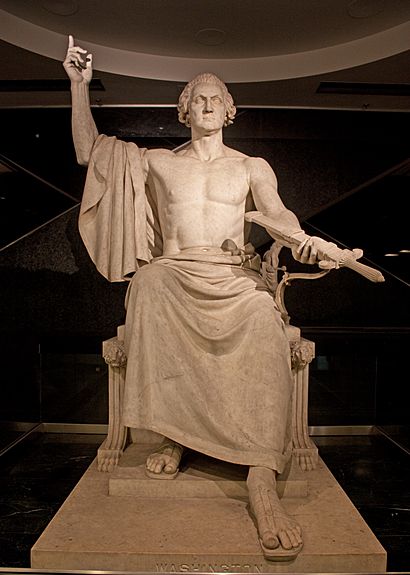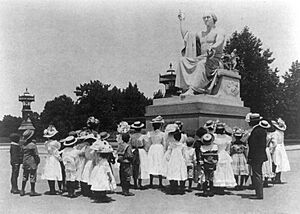George Washington (Greenough) facts for kids
Quick facts for kids George Washington |
|
|---|---|
 |
|
| Artist | Horatio Greenough |
| Year | 1840 |
| Type | Carrara marble |
| Dimensions | 3.5 m × 2.6 m (136 in × 102 in × 82 1/2 in) |
| Location | National Museum of American History, Washington, D.C., United States |
| Owner | Smithsonian Institution |
The George Washington statue, also called Enthroned Washington, is a very large marble sculpture. It was created by Horatio Greenough. The United States Congress asked for this statue on July 14, 1832. This was to celebrate 100 years since U.S. President George Washington was born. He was born on February 22, 1732.
The statue was finished in 1840. It was first shown in the Rotunda of the U.S. Capitol. Later, in 1843, it was moved outside to the Capitol's east lawn. Since 1964, you can see it at the National Museum of American History. Greenough based his design on an ancient Greek statue. This was the famous Zeus Olympios, which was one of the Seven Wonders of the Ancient World.
What the Statue Shows
This statue shows George Washington sitting on a grand chair. He looks very serious and is wearing sandals, like people did in ancient Rome. He is bare-chested, meaning he doesn't have a shirt on.
- His right hand points up towards the sky.
- In his left hand, he holds a sword that is still in its cover. This shows that Washington gave up his power after the American Revolutionary War. He wanted the power to belong to the people.
The way Washington is dressed, like a Roman hero, is part of a style called Neoclassicism. This art style was popular at the time. It looked back to the art and ideas of ancient Greece and Rome.
On the back of the statue, there is a message written in Latin. It means: "Horatio Greenough made this image as a great example of freedom. Freedom will not last without freedom itself."
The Statue's Journey
On July 14, 1832, the U.S. Congress asked Greenough to make this statue. They wanted it for the U.S. Capitol rotunda. The large marble statue arrived in Washington, D.C. from Italy on July 31, 1841.
When it was put in the rotunda in December 1841, many people did not like it. They thought it looked strange. Because the statue was so heavy and the rotunda was dim, it was moved outside in 1843. It was placed on a pedestal on the Capitol's east lawn.
People still made jokes about it. Some said Washington looked like he was reaching for his clothes. His clothes were actually on display at the Patent Office nearby.
The statue was brought back inside to the Smithsonian Castle. This happened after Congress agreed to move it on May 22, 1908. It stayed there until 1964. Then, it was moved to the new Museum of History and Technology. This museum is now called the National Museum of American History. The statue has been on the second floor of the museum ever since.


